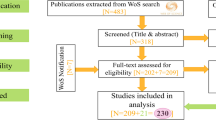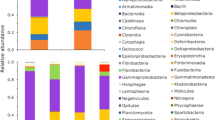Abstract
Probiotics can ameliorate diseases of humans and wildlife, but the mechanisms remain unclear. Host responses to interventions that change their microbiota are largely uncharacterized. We applied a consortium of four natural antifungal bacteria to the skin of endangered Sierra Nevada yellow-legged frogs, Rana sierrae, before experimental exposure to the pathogenic fungus Batrachochytrium dendrobatidis (Bd). The probiotic microbes did not persist, nor did they protect hosts, and skin peptide sampling indicated immune modulation. We characterized a novel skin defense peptide brevinin-1Ma (FLPILAGLAANLVPKLICSITKKC) that was downregulated by the probiotic treatment. Brevinin-1Ma was tested against a range of amphibian skin cultures and found to inhibit growth of fungal pathogens Bd and B. salamandrivorans, but enhanced the growth of probiotic bacteria including Janthinobacterium lividum, Chryseobacterium ureilyticum, Serratia grimesii, and Pseudomonas sp. While commonly thought of as antimicrobial peptides, here brevinin-1Ma showed promicrobial function, facilitating microbial growth. Thus, skin exposure to probiotic bacterial cultures induced a shift in skin defense peptide profiles that appeared to act as an immune response functioning to regulate the microbiome. In addition to direct microbial antagonism, probiotic-host interactions may be a critical mechanism affecting disease resistance.





Similar content being viewed by others
References
Nissen-Meyer J, Nes IF (1997) Ribosomally synthesized antimicrobial peptides: their function, structure, biogenesis, and mechanism of action. Arch. Microbiol. 167:67–77
Finlay BB, Hancock REW (2004) Can innate immunity be enhanced to treat microbial infections? Nature Rev. Microbiol. 2:497–504
Zasloff M (2002) Antimicrobial peptides of multicellular organisms. Nature 415:389–395
García-Bayona L, Comstock LE (2018) Bacterial antagonism in host-associated microbial communities. Science 361(6408). https://doi.org/10.1126/science.aat2456
Conlon JM (2011) The contribution of skin antimicrobial peptides to the system of innate immunity in anurans. Cell Tissue Res. 343:201–212. https://doi.org/10.1007/s00441-010-1014-4
Bell SC, Garland S, Alford RA (2018) Increased numbers of culturable inhibitory bacterial taxa may mitigate the effects of Batrachochytrium dendrobatidis in Australian wet tropics frogs. Front. Microbiol. 9:1604. https://doi.org/10.3389/fmicb.2018.01604
Voyles J, Woodhams DC, Saenz V, Byrne AQ, Perez R, Rios-Sotelo G, Ryan MJ, Bletz MC, Sobell FA, McLetchie S, Reinert L, Rosenblum EB, Rollins-Smith LA, Ibáñez R, Ray JM, Griffith EJ, Ross H, Richards-Zawacki CL (2018) Shifts in disease dynamics in a tropical amphibian assemblage are not due to pathogen attenuation. Science 359(6383):1517–1519. https://doi.org/10.1126/science.aao4806
Haine ER, Moret Y, Siva-Jothy MT, Rolff J (2008) Antimicrobial defense and persistent infection in insects. Science 322:1257–1259
Mishra B, Reiling S, Zarena D, Wang G (2017) Host defense antimicrobial peptides as antibiotics: design and application strategies. Curr. Opin. Chem. Biol. 38:87–96. https://doi.org/10.1016/j.cbpa.2017.03.014
Zasloff M (2006) Inducing endogenous antimicrobial peptides to battle infections. Proc. Natl. Acad. Sci. U. S. A. 103:8913–8914
Gudmundsson GH, Bergman P, Andersson J, Raqib R, Agerberth B (2010) Battle and balance at mucosal surfaces – the story of Shigella and antimicrobial peptides. Biochem. Biophys. Res. Comm. 396:116–119
Kriss M, Hazleton KZ, Nusbacher NM, Martin CG, Lozupone CA (2108) Low diversity gut microbiota dysbiosis: drivers, functional implications and recovery. Curr. Opin. Microbiol. 44:34–40. https://doi.org/10.1016/j.mib.2018.07.003
Radek KA, Elias PM, Taupenot L, Mahata SK, O’Connor DT, Gallo RL (2010) Neuroendocrine nicotinic receptor activation increases susceptibility to bacterial infections by suppressing antimicrobial peptide production. Cell Host Microbe 7:277–289
Matutte B, Storey KB, Knoop FC, Conlon JM (2000) Induction of synthesis of an antimicrobial peptide in the skin of the freeze-tolerant frog, Rana sylvatica, in response to environmental stimuli. FEBS Lett. 483:135–138
Bilusich D, Jackway RJ, Musgrave IF, Tyler MJ, Bowie JH (2009) The host-defence skin peptide profiles of Peron’s Tree Frog Litoria peronii in winter and summer. Sequence determination by electrospray mass spectrometry and activities of the peptides. Rapid Commun. Mass Spectrom. 23:2628–2636
Sherman PJ, Jackway RJ, Nicholson E, Musgrave IF, Boontheung P, Bowie JH (2009) Activities of seasonably variable caerulein and rothein skin peptides from the tree frogs Litoria splendida and Litoria rothii. Toxicon 54:828–835
Mangoni ML, Miele R, Renda TG, Barra D, Simmaco M (2001) The synthesis of antimicrobial peptides in the skin of Rana esculenta is stimulated by microorganisms. FASEB J. 15:1431–1432
Kraus D, Peschel A (2008) Staphylococcus aureus evasion of antimicrobial defense. Future Microbiol 3:437–451
Schadich E, Cole AL (2009) Inhibition of frog antimicrobial peptides by extracellular products of the bacterial pathogen Aeromonas hydrophila. Lett. Appl. Microbiol. 49:384–387
Makarova O, Johnston P, Rodriguez-Rojas A, El Shazely B, Morales JM, Rolff J (2018) Genomics of experimental adaptation of Staphylococcus aureus to a natural combination of insect antimicrobial peptides. Sci. Rep. 8(1):15359. https://doi.org/10.1038/s41598-018-33593-7
Perron GG, Zasloff M, Bell G (2006) Experimental evolution of resistance to an antimicrobial peptide. Proc. R. Soc. B 273:251–256
Oard SV, Enright FM (2006) Expression of the antimicrobial peptides in plants to control phytopathogenic bacteria and fungi. Plant Cell Rep. 25:561–572
Parisien A, Allain B, Zhang J, Mandeville R, Lan CQ (2008) Novel alternatives to antibiotics: bacteriophages, bacterial cell wall hydrolases, and antimicrobial peptides. J. Appl. Microbiol. 104(1):1–13. https://doi.org/10.1111/j.1365-2672.2007.03498.x
Mookherjee N, Hancock RE (2007) Cationic host defence peptides: innate immune regulatory peptides as a novel approach for treating infections. Cell. Mol. Life Sci. 64:922–933
Harris RN, Brucker RM, Walke JB, Becker MH, Schwantes CR, Flaherty DC, Lam BA, Woodhams DC, Briggs CJ, Vredenburg VT, Minbiole KP (2009) Skin microbes on frogs prevent morbidity and mortality caused by a lethal skin fungus. ISME J. 3:818–824
Brucker RM, Harris RN, Schwantes CR, Gallaher TN, Flaherty DC, Lam BA, Minbiole KP (2008) Amphibian chemical defense: antifungal metabolites of the microsymbiont Janthinobacterium lividum on the salamander Plethodon cinereus. J. Chem. Ecol. 34:1422–1429
Woodhams DC, Alford RA, Antwis RE, Archer H, Becker MH, Belden LK, Bell SC, Bletz M, Daskin JH, Davis LR, Flechas SV, Lauer A, Gonzalez A, Harris RN, Holden WM, Hughey MC, Ibáñez R, Knight R, Kueneman J, Rabemananjara F, Reinert LK, Rollins-Smith LA, Roman-Rodriguez F, Shaw SD, Walke JB, McKenzie V (2015) Antifungal isolates database of amphibian skin-associated bacteria and function against emerging fungal pathogens. Ecology 96:595. https://doi.org/10.1890/14-1837.1
Bletz M, Loudon A, Becker M, Bell S, Woodhams DC, Minbiole KPC, Harris R (2013) Mitigating amphibian chytridiomycosis with bioaugmentation: characteristics of effective probiotics and strategies for their selection and use. Ecol. Lett. 16:807–820. https://doi.org/10.1111/ele.12099
Rebollar EA, Antwis RE, Becker MH, Belden LK, Bletz MC, Brucker RM, Harrison XA, Hughey MC, Kueneman JG, Loudon AH, McKenzie V, Medina D, Minbiole KPC, Rollins-Smith LA, Walke JB, Weiss S, Woodhams DC, Harris RN (2016) Using “omics” and integrated multi-omics approaches to guide probiotic selection to mitigate chytridiomycosis and other emerging infectious diseases. Front. Microbiol. 7:68. https://doi.org/10.3389/fmicb.2016.00068
Rollins-Smith LA, Woodhams DC, Reinert LK, Vredenburg VT, Briggs CJ, Nielsen PF, Conlon JM (2006) Antimicrobial peptide defenses of the mountain yellow-legged frog (Rana muscosa). Dev. Comp. Immunol. 30:831–842
Woodhams DC, Barnhart K, Bletz MC, Campos A, Ganem SJ, Hertz A, LaBumbard B, Nanjappa P, Peters A.(2018) Batrachochytrium: biology and management of a fungal pathogen of amphibians. . In: eLS John Wiley & Sons, Ltd: Chichester. DOI: https://doi.org/10.1002/9780470015902.a0027207
Wyngaard GA, Chinnappa CC (1982) General biology and cytology of cyclopoids, in: F.W. Harrison, R.R. Cowden (Eds.), Developmental biology of freshwater invertebrates, AR Liss: New York, 1982, pp. 485–533
Becker MH, Harris RN (2010) Cutaneous bacteria of the redback salamander prevent morbidity associated with a lethal disease. PLoS One 5(6):e10957. https://doi.org/10.1371/journal.pone.0010957
Woodhams DC, Rollins-Smith LA, Briggs CJ, Vredenburg VT, Simon MA, Billheimer D, Shakhtour B, Shyr Y, Harris RN (2007) Symbiotic bacteria contribute to innate immune defenses of the threatened mountain yellow-legged frog, Rana muscosa. Biol. Conserv. 138:390–398
Goel MK, Khanna P, Kishore J (2010) Understanding survival analysis: Kaplan-Meier estimate. Int. J. Ayurveda Res. 1(4):274–278. https://doi.org/10.4103/0974-7788.76794
Blaustein AR, Alford RA, Harris RN (2009) The value of well-designed experiments in studying diseases with special reference to amphibians. EcoHealth 6:373–377
Lauer A, Simon MA, Banning JL, Lam BA, Harris RN (2008) Diversity of cutaneous bacteria with antifungal activity isolated from female four-toed salamanders. ISME J. 2:145–157
Walke MA, Harris RN, Reinert LK, Rollins-Smith LA, Woodhams DC (2011) Social immunity in amphibians: evidence for vertical transmission of innate defenses. Biotropica 43:396–400
Rollins-Smith LA, Carey C, Longcore J, Doersam JK, Boutte A, Bruzgal JE, Conlon JM (2002) Activity of antimicrobial skin peptides from ranid frogs against Batrachochytrium dendrobatidis, the chytrid fungus associated with global amphibian declines. Dev. Comp. Immunol. 26:471–479
Wang G, Li X, Wang Z (2016) APD3: the antimicrobial peptide database as a tool for research and education. Nucl. Acids Res. 44:D1087–D1093
Woodhams DC, LaBumbard BC, Barnhart KL, Becker MH, Bletz MC, Escobar LA, Flechas SV, Forman ME, Iannetta AA, Joyce MD, Rabemananjara F, Gratwicke B, Vences M, Minbiole KPC (2018) Prodigiosin, violacein, and volatile organic compounds produced by widespread cutaneous bacteria of amphibians can inhibit two Batrachochytrium fungal pathogens. Microb. Ecol. 75:1049–1062. https://doi.org/https://doi.org/10.1007/s00248-017-1095-7
Conlon JM, Kolodziejek J, Nowotny N (2009) Antimicrobial peptides from the skins of North American frogs. Biochim. Biophys. Acta 1788:1556–1563
Rollins-Smith LA, Conlon JM (2005) Antimicrobial peptide defenses against chytridiomycosis, an emerging infectious disease of amphibian populations. Dev. Comp. Immunol. 29:589–598
Flechas SV, Acosta-González A, Escobar LA, Kueneman JG, Sánchez-Quitian ZA, Parra-Giraldo CM, Rollins-Smith LA, Reinert LK, Vredenburg VT, Amézquita A, Woodhams DC (2019) Microbiota and skin defense peptides may facilitate coexistence of two sympatric Andean frog species with a lethal pathogen. ISME J. 13:361–373. https://doi.org/10.1038/s41396-018-0284-9
Jani AJ, Briggs CJ (2014) The pathogen Batrachochytrium dendrobatidis disturbs the frog skin microbiome during a natural epidemic and experimental infection. Proc. Natl. Acad. Sci. U. S. A. 111(47):E5049–E5058. https://doi.org/10.1073/pnas.1412752111
Butt TM, Copping LG (2000) Fungal biological control agents. Pestic. Outlook 11:186–191
Yang C, Crowley DE, Menge JA (2001) 16S rDNA fingerprinting of rhizosphere bacterial communities associated with healthy and Phytophthora infected avocado roots. FEMS Microbiol. Ecol. 35:129–136
Nikoskelainen S, Ouwehand AC, Bylund G, Salminen S, Lilius EM (2003) Immune enhancement in rainbow trout (Oncorhynchus mykiss) by potential probiotic bacteria (Lactobacillus rhamnosus). Fish Shellfish Immunol. 15:443–452
Reid G, Younes YA, Van der Mei HC, Gloor GB, Knight R, Busscher HJ (2011) Microbiota restoration: natural and supplemented recovery of human microbial communities. Nat. Rev. Microbiol. 9:27–38
Wilkins T, Sequoia J (2017) Probiotics for gastrointestinal conditions: a summary of the evidence. Am. Fam. Physician 96:170–178
McKenzie VJ, Kueneman JG, Harris RN (2018) Probiotics as a tool for disease mitigation in wildlife: insights from food production and medicine. Ann. N. Y. Acad. Sci. 1429:18–30. https://doi.org/10.1111/nyas.13617
Kueneman JG, Woodhams DC, Harris R, Archer HM, Knight R, McKenzie VJ (2016) Probiotic treatment restores protection against lethal fungal infection lost during amphibian captivity. Proc. R. Soc. B 283:20161553. http://dx.doi.org/https://doi.org/10.1098/rspb.2016.1553
Chen K, Cerutti A (2010) Vaccination strategies to promote mucosal antibody responses. Immunity 33:479–491
Krutmann J (2009) Pre- and probiotics for human skin. J. Dermatol. Sci. 54:1–5
Acknowledgements
We thank Tara Adiseshan for assistance with DGGE. This research was supported by a Sanofi Genzyme Undergraduate Research Fellowship to B.T.P., the U.S. National Science Foundation grant numbers 0640373 to R.N.H. and 1121758 to L.R-S., and the Swiss National Science Foundation grant number 31-125099 to D.C.W. with additional financial assistance from the Faculty of Science, University of Zurich.
Author information
Authors and Affiliations
Corresponding author
Electronic Supplementary Material
ESM 1
(DOCX 257 kb)
Rights and permissions
About this article
Cite this article
Woodhams, D.C., Rollins-Smith, L.A., Reinert, L.K. et al. Probiotics Modulate a Novel Amphibian Skin Defense Peptide That Is Antifungal and Facilitates Growth of Antifungal Bacteria. Microb Ecol 79, 192–202 (2020). https://doi.org/10.1007/s00248-019-01385-9
Received:
Accepted:
Published:
Issue Date:
DOI: https://doi.org/10.1007/s00248-019-01385-9




